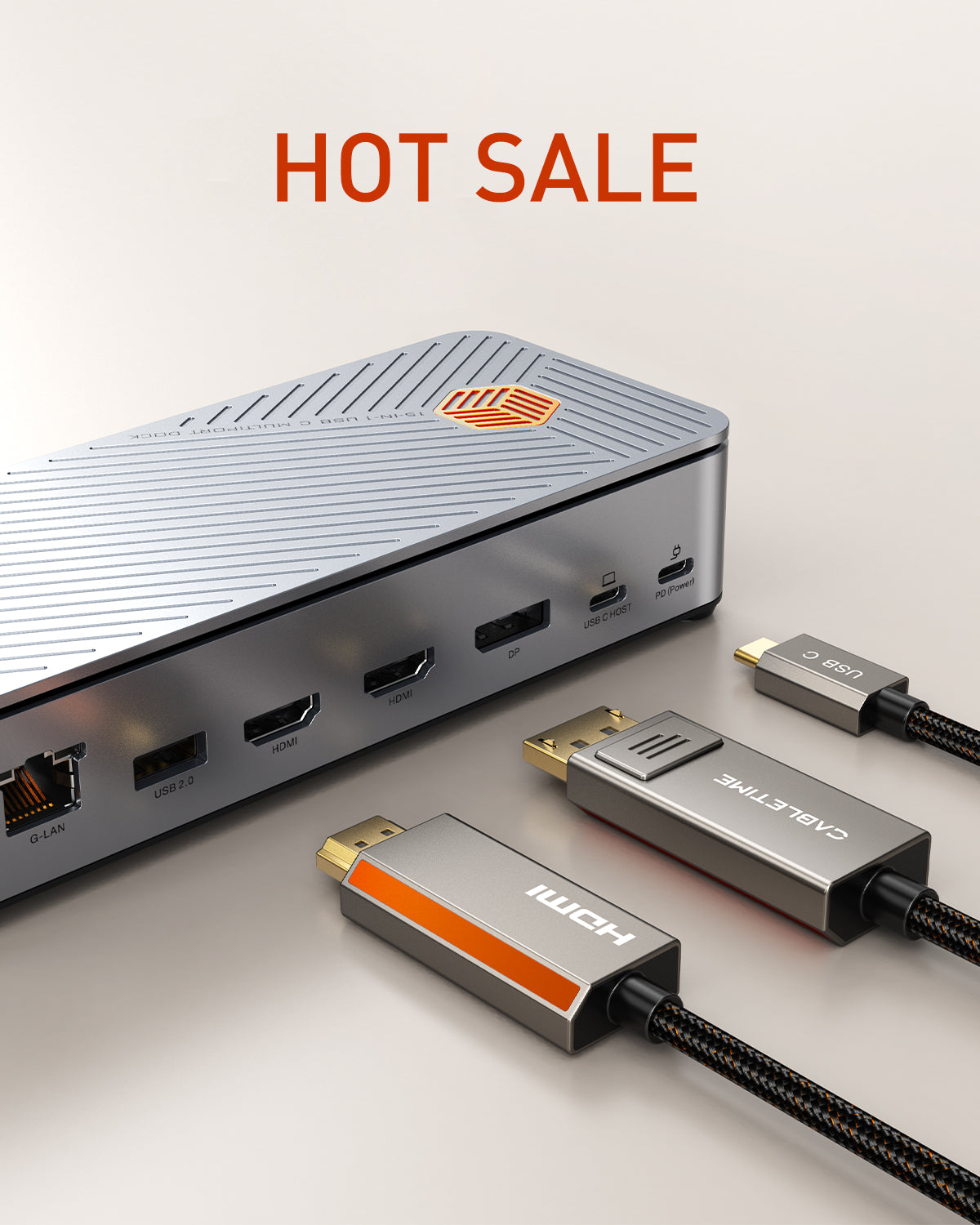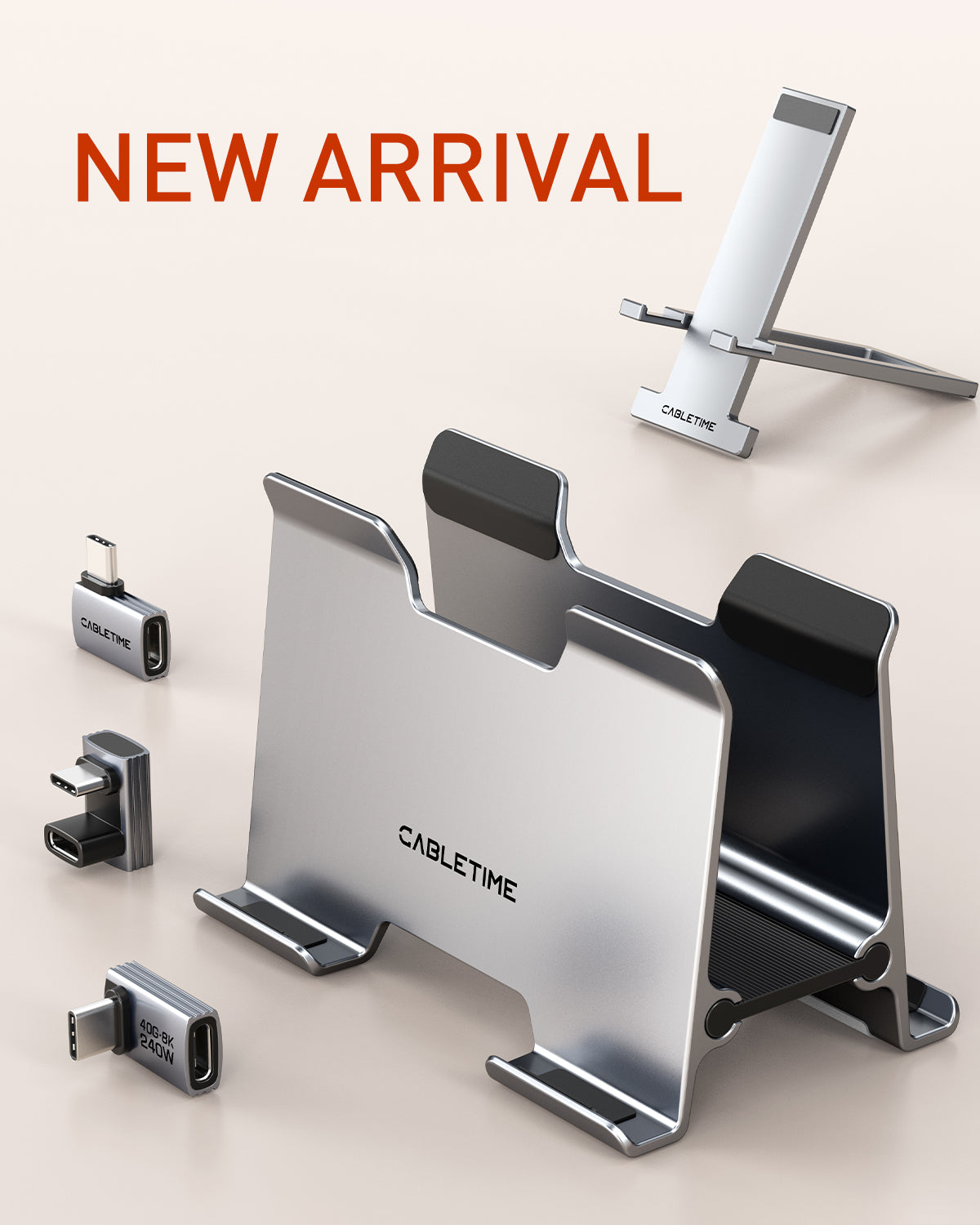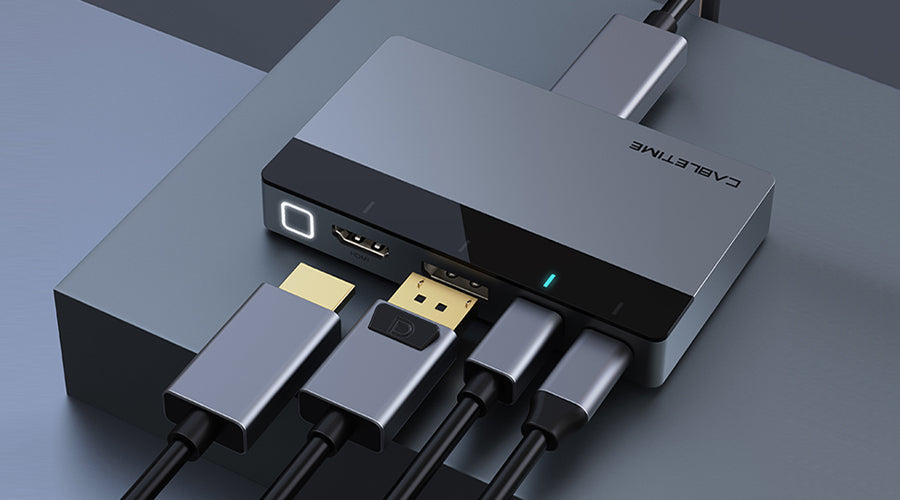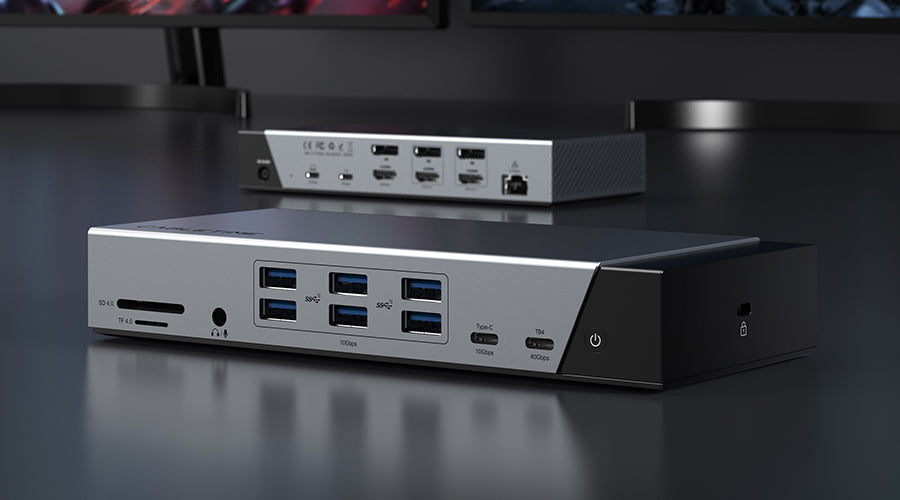การเชื่อมต่อ USB กลายเป็นสิ่งที่พบเห็นได้ทั่วไป แต่สายเคเบิลที่เราใช้มีข้อจำกัดด้านระยะทางที่เข้มงวด ซึ่งมักทำให้การใช้งานของเราเกิดความยุ่งยาก แต่สายเคเบิลแบบพิเศษ โซลูชันสายเคเบิล มีไว้เพื่อเอาชนะข้อจำกัดเหล่านี้ คู่มือนี้ครอบคลุมทุกอย่างตั้งแต่หลักวิทยาศาสตร์เบื้องหลังข้อจำกัดความยาวของ USB ไปจนถึงการแก้ไขปัญหาในทางปฏิบัติที่ยืดระยะการเชื่อมต่อให้ยาวเกินระยะทางที่เป็นไปไม่ได้มาก่อน อ่านต่อเพื่อรับความยืดหยุ่นที่คุณต้องการจาก USB
สารบัญ
ทำความเข้าใจข้อจำกัดความยาวของสายเคเบิล USB

แม้จะมีข้อดีหลายประการ แต่สายเคเบิล USB ก็มีข้อจำกัดด้านความยาวเฉพาะที่แตกต่างกันไปขึ้นอยู่กับเวอร์ชันของ USB ข้อจำกัดเหล่านี้มีไว้เพื่อให้แน่ใจว่าความเร็วในการถ่ายโอนข้อมูลและความสมบูรณ์ของสัญญาณจะเหมาะสมที่สุด ต่อไปนี้คือรายละเอียดของความยาวสายเคเบิลสูงสุดสำหรับ USB เวอร์ชันต่างๆ:
- USB 1.1: 5 เมตร (16.4 ฟุต) ด้วยความเร็วการถ่ายโอนข้อมูล 12 Mbps
- USB 2.0: 5 เมตร (16.4 ฟุต) พร้อมความเร็วในการถ่ายโอนข้อมูล 480 Mbps
- USB 3.0: 3 เมตร (9.8 ฟุต) พร้อมความเร็วในการถ่ายโอนข้อมูล 5 Gbps
- USB 3.1: 3 เมตร (9.8 ฟุต) ด้วยความเร็วการถ่ายโอนข้อมูล 10 Gbps
- USB 3.2: 0.8 เมตร (2.6 ฟุต) ด้วยความเร็วการถ่ายโอนข้อมูล 20 Gbps
- USB4: 0.8 เมตร (2.6 ฟุต) พร้อมความเร็วในการถ่ายโอนข้อมูล 40 Gbps
ข้อจำกัดเหล่านี้มีไว้เพื่อรักษาคุณภาพสัญญาณและเพื่อให้แน่ใจว่าสามารถบรรลุความเร็วการถ่ายโอนข้อมูลตามที่กำหนดได้ หากเกินขีดจำกัดความยาวเหล่านี้อาจส่งผลให้สัญญาณลดลง ความเร็วในการถ่ายโอนข้อมูลลดลง และอาจทำให้เกิดปัญหาการเชื่อมต่อ
วิทยาศาสตร์เบื้องหลังข้อจำกัดระยะทาง USB
สาย USB มีตัวนำแยกกันสี่เส้น ได้แก่ สายคู่บิดเกลียวสำหรับส่งข้อมูลและสายไฟ เมื่อสัญญาณ USB เดินทางผ่านสายบางๆ เหล่านี้ ความต้านทานแม่เหล็กไฟฟ้าจะทำให้สายเกิดการบิดเบือน ยิ่งสายไปไกลเท่าไร ก็ยิ่งเสื่อมสภาพลงมากเท่านั้น จนอุปกรณ์ไม่สามารถสื่อสารกันได้อย่างถูกต้องอีกต่อไป
ปัจจัยสำคัญเพิ่มเติมที่ส่งผลต่อความสามารถในการวัดระยะทางของ USB ได้แก่:
- ความไม่ตรงกันของค่าอิมพีแดนซ์ของสัญญาณ:ความไม่ตรงกันของค่าอิมพีแดนซ์ระหว่างตัวนำจะสะท้อนสัญญาณข้อมูลแทนที่จะดูดซับสัญญาณเหล่านั้น ทำให้เกิดปัญหาการรบกวนของเสียงสะท้อน อิมพีแดนซ์ของแหล่งและปลายทาง USB ที่ไม่ตรงกันจะยิ่งแย่ลงเมื่อความยาวของสายเพิ่มขึ้น
- สัญญาณรบกวนทางแม่เหล็กไฟฟ้า (EMI):พลังงานแม่เหล็กไฟฟ้าภายนอกสามารถเชื่อมต่อแบบเหนี่ยวนำหรือแบบเก็บประจุกับสาย USB ซึ่งจะทำให้สัญญาณข้อมูลเสียหาย อุปกรณ์โทรศัพท์ มอเตอร์ จอภาพ และสายไฟ AC ที่อยู่ตามสายส่งสัญญาณรบกวนที่กรองได้ยาก
- ประสิทธิภาพการส่งพลังงานต่ำ:สายเคเบิลที่ยาวเกินไปจนไม่สามารถจ่ายกระแสไฟให้กับอุปกรณ์ USB ได้เพียงพอ อาจทำให้เกิดการตัดการเชื่อมต่อเป็นระยะๆ ไฟตก และเกิดปัญหากับฮาร์ดแวร์ในระยะยาว
- การก่อสร้างที่มีคุณภาพต่ำ:สายเคเบิลคุณภาพต่ำมักไม่ใช้เทคนิคการบิด วัสดุป้องกัน การจับคู่ค่าอิมพีแดนซ์ และการกรองสัญญาณรบกวนที่ถูกต้อง ซึ่งช่วยต่อสู้กับภัยคุกคามจากการเสื่อมถอยของสัญญาณ
- ความเร็วในการถ่ายโอนข้อมูล:ความเร็วในการถ่ายโอนข้อมูลผ่าน USB จะลดลงเมื่อความยาวของสายเคเบิลเพิ่มขึ้น เนื่องจากสัญญาณลดทอน ความคลาดเคลื่อนของเวลา และความไวต่อสัญญาณรบกวนที่เพิ่มมากขึ้น สายเคเบิลที่ยาวขึ้นจะเกิดสัญญาณอ่อนลง ผิดเพี้ยน และความล่าช้าในการแพร่กระจายมากขึ้น ซึ่งอาจนำไปสู่ปัญหาการซิงโครไนซ์และข้อผิดพลาดของข้อมูล ผลกระทบเหล่านี้เด่นชัดมากขึ้นในมาตรฐาน USB ความเร็วสูง ซึ่งท้ายที่สุดแล้วจะทำให้จำกัดอัตราการถ่ายโอนข้อมูลสูงสุดที่ทำได้ในระยะที่ไกลออกไป
ปัจจัยเหล่านี้เมื่อนำมารวมกันจะทำให้สายเคเบิล USB ไม่สามารถไปถึงความยาวสูงสุดที่กำหนดได้โดยไม่ต้องใช้การแทรกแซงทางวิศวกรรมขั้นสูง
ผลที่ตามมาจากการใช้สายเคเบิลที่ยาวเกินไป
การเกินเกณฑ์ความยาวที่แนะนำสำหรับมาตรฐาน USB จะทำให้เกิดปัญหาต่างๆ เช่น:
- การเชื่อมต่อล้มเหลว:อุปกรณ์จะตัดการเชื่อมต่อโดยสุ่ม / ไม่สามารถเชื่อมต่อได้อย่างสมบูรณ์เมื่อเสียบปลั๊กครั้งแรก
- การเชื่อมต่อไม่เสถียร:การเชื่อมต่อแบบบางส่วนซึ่งอุปกรณ์จะเชื่อมต่อกันในช่วงสั้นๆ จากนั้นจะหลุดออกมาอีกครั้งอย่างไม่มีที่สิ้นสุด จำเป็นต้องเดินสายเคเบิลใหม่อีกครั้ง
- ความเร็วในการถ่ายโอนข้อมูลช้า:ลดความเร็วในการอ่าน/เขียนไปยังไดรฟ์หรืออุปกรณ์ต่อพ่วงที่เชื่อมต่ออย่างมาก การถ่ายโอนไฟล์ขนาดใหญ่ล้มเหลว
- ข้อผิดพลาดของสัญญาณทำให้เกิดการขัดข้อง:การถ่ายโอนข้อมูลที่เสียหายทำให้เกิดอาการหยุดนิ่ง อินพุต/เอาต์พุตล้มเหลว และระบบปฏิบัติการล่ม
- ปัญหาความเข้ากันได้:ไม่สามารถตรวจจับอุปกรณ์ที่เชื่อมต่อได้เลย มาตรฐาน USB จะตรวจจับการละเมิดเมื่อการสื่อสารแบบแฮนด์เชคล้มเหลวและยอมแพ้
แม้ว่าบางครั้งระยะทางที่สั้นกว่าข้อกำหนดจะยาวกว่าเล็กน้อย แต่การขยายสายเคเบิลให้ยาวเกินไปอาจส่งผลต่อการทำงานและเสี่ยงต่อความเสียหายของอุปกรณ์ในระยะยาว จำเป็นต้องมีการออกแบบโซลูชันอย่างรอบคอบเพื่อเพิ่มความยาวโดยไม่เกิดผลที่ตามมา
เคล็ดลับสำหรับการเดินสาย USB ที่เชื่อถือได้
เมื่อทำการเชื่อมต่อ USB ควรปฏิบัติตามแนวทางปฏิบัติที่ดีบางประการเพื่อช่วยเพิ่มระยะทางสายเคเบิลให้สูงสุด:
- ใช้สาย USB หนาคุณภาพสูงที่มีตัวนำบิดแน่นเพื่อจำกัดสัญญาณรบกวนและสัญญาณรบกวนข้ามสาย มองหาโช้กเฟอร์ไรต์ที่ปลายสายอย่างน้อยหนึ่งปลายเพื่อระงับสัญญาณรบกวน EMI
- วางสายเคเบิลให้ห่างจากแหล่งรบกวนที่อาจเกิดขึ้น เช่น สายไฟที่ไม่มีฉนวนหุ้ม มอเตอร์ จอภาพ และอุปกรณ์โทรศัพท์ โดยเฉพาะอย่างยิ่งสายเคเบิล USB 3.0 จะต้องพิจารณาเรื่อง EMI อย่างรอบคอบ เนื่องจากความถี่ที่สูงขึ้นจะปล่อยสนามแม่เหล็กไฟฟ้าที่แรงกว่า
- ตรวจสอบให้แน่ใจว่าสายเคเบิลจะวิ่งผ่านเส้นทางตรงที่สุดระหว่างอุปกรณ์ต่างๆ โดยไม่โค้งงอหรือบีบแน่นเกินไป การเดินสายแบบค่อยเป็นค่อยไปจะช่วยจำกัดสัญญาณรบกวนและการสะท้อนของสัญญาณภายในสายเคเบิล
- หากเป็นไปได้ ให้เชื่อมต่ออุปกรณ์เข้ากับพอร์ต USB รูทบนคอมพิวเตอร์โฮสต์โดยตรง แทนที่จะเชื่อมต่อผ่านฮับปลายทางหรือพอร์ตจำลอง วิธีนี้จะช่วยหลีกเลี่ยงการรบกวนที่เกิดจากตัวควบคุมรอง
- พิจารณาใช้การแยกสัญญาณแสงที่จุดปลายสายเคเบิลเพื่อบล็อกกระแสไฟฟ้าจากสายดินที่ก่อให้เกิดสัญญาณรบกวน ติดตั้งโมดูลกรองสัญญาณหากไม่สามารถหลีกเลี่ยงสัญญาณรบกวนทางไฟฟ้าได้
การใช้เทคนิคสายเคเบิล USB ที่ถูกต้องจะช่วยเพิ่มระยะการทำงานได้ แต่เมื่อต้องใช้สายต่อขยายเกิน 20 ฟุต จำเป็นต้องใช้วิธีการขั้นสูง
การทำลายข้อจำกัดความยาวของ USB
1. การใช้สาย USB Active

สาย USB แบบแอ็คทีฟสามารถใช้เพื่อขยายความยาวของการเชื่อมต่อ USB ให้ยาวขึ้นเกินกว่าขีดจำกัดมาตรฐาน สายเหล่านี้ประกอบด้วยวงจรอิเล็กทรอนิกส์แอ็คทีฟขนาดเล็กที่ฝังอยู่ภายในปลอกหุ้มสาย ช่วยให้ข้อมูลไหลผ่านด้วยความเร็วสูงได้อย่างต่อเนื่องในระยะทางที่ไกลขึ้น
สาย USB แอ็คทีฟทำงานอย่างไร?
สายเคเบิลแอ็คทีฟจะรวมวงจรรีพีทเตอร์ขนาดเล็กที่เว้นระยะเป็นระยะภายในสายเคเบิล วงจรเหล่านี้จะตรวจจับและปรับสภาพสัญญาณ USB ที่เสื่อมสภาพ ปรับเปลี่ยนรูปร่าง ขยายสัญญาณใหม่ และส่งสัญญาณใหม่เพื่อรักษาความสมบูรณ์ของสัญญาณในระยะทางที่ไกลขึ้น
ความยาวที่เพิ่มขึ้นด้วยสายเคเบิลแอ็คทีฟ
ตามข้อมูลที่ให้มา สายต่อขยายแบบใช้งานได้สามารถเพิ่มความยาวสูงสุดสำหรับ USB เวอร์ชันต่างๆ ได้อย่างมาก:
- USB 2.0: สูงสุด 30 เมตร (98 ฟุต) เมื่อเทียบกับ 5 เมตร (16.4 ฟุต) สำหรับสายเคเบิลมาตรฐาน
- USB 3.0 และ 3.1: สูงสุด 18 เมตร (59 ฟุต) เมื่อเทียบกับ 3 เมตร (9.8 ฟุต) สำหรับสายเคเบิลมาตรฐาน
- USB 3.2 และ USB 4: สูงสุด 3 เมตร (9.8 ฟุต) เมื่อเทียบกับ 0.8 เมตร (2.6 ฟุต) สำหรับสายเคเบิลมาตรฐาน
สายต่อขยายแบบแอ็คทีฟเหล่านี้ช่วยให้ผู้ใช้สามารถรักษาการเชื่อมต่อ USB ที่เชื่อถือได้ในระยะทางที่สายเคเบิลแบบพาสซีฟมาตรฐานไม่สามารถทำได้ ทำให้เหมาะอย่างยิ่งสำหรับสถานการณ์ที่ต้องใช้สายเคเบิลในระยะทางยาว
2. การใช้ฮับ USB และรีพีทเตอร์

นอกเหนือจากการอัพเกรดเป็นสายเคเบิลแบบแอ็คทีฟแล้ว ฮับ USB และอุปกรณ์ขยายสัญญาณช่วยให้ขยายระยะทางของสายเคเบิลได้ง่ายขึ้น โดยทำหน้าที่เป็นส่วนท่อส่งไฟฟ้าแบบง่ายๆ แทนที่จะประมวลผลและแก้ไขสัญญาณ ทำให้สามารถเชื่อมต่อท่อ USB ได้ไกลขึ้นอย่างน่าประหลาดใจ
แนวทางการใช้ฮับ USB
ฮับ USB สามารถรับ ขยาย และสร้างสัญญาณ USB ใหม่ได้ การเสียบฮับ USB ไว้ตรงกลางสาย USB จะทำให้ขยายระยะการส่งสัญญาณได้อย่างมีประสิทธิภาพ ช่วยให้คุณเชื่อมต่ออุปกรณ์ที่อยู่ห่างจากระบบโฮสต์ได้
นอกจากนี้ การเชื่อมต่อฮับ USB หลายตัวเข้าด้วยกันแบบเดซี่เชนยังช่วยเพิ่มพื้นที่ครอบคลุมและขยายระยะการส่งสัญญาณได้อีกด้วย เทคนิคนี้ช่วยให้การเชื่อมต่อ USB เข้าถึงห้องต่างๆ หรือแม้แต่ชั้นต่างๆ ของอาคารที่อยู่ห่างจากคอมพิวเตอร์โฮสต์ได้
อย่างไรก็ตาม แม้ว่าฮับแต่ละตัวจะสามารถเพิ่มระยะทางได้ แต่สิ่งสำคัญคือต้องคำนึงถึงข้อจำกัดของแนวทางนี้:
- ข้อจำกัดแบนด์วิดท์: แบนด์วิดท์รวมของมาตรฐาน USB ที่ใช้จะต้องแบ่งปันระหว่างอุปกรณ์ที่เชื่อมต่อทั้งหมด
- ข้อจำกัดของระดับการเชื่อมต่อ: ข้อกำหนด USB มักจะจำกัดจำนวนระดับในการกำหนดค่าแบบเดซี่เชน
- ข้อกังวลด้านเสถียรภาพ: เมื่อโซ่ของฮับยาวขึ้น การรักษาคุณภาพการเชื่อมต่อที่เสถียรก็กลายเป็นเรื่องท้าทายมากขึ้น
เพื่อให้แน่ใจว่าอุปกรณ์ทำงานได้อย่างเหมาะสมและรักษาคุณภาพการเชื่อมต่อที่เสถียร จึงมีความจำเป็นอย่างยิ่งที่จะต้องพิจารณาปัจจัยเหล่านี้เมื่อวางแผนการตั้งค่า USB ขยายโดยใช้ฮับ
วิธีการใช้รีพีทเตอร์ USB
นอกจากนี้ ตัวขยายสัญญาณ USB หรือตัวขยายสัญญาณบูสเตอร์แบบธรรมดาจะเชื่อมต่อแบบอินไลน์ตามสายเคเบิลที่ยาวเกินไป เพื่อส่งสัญญาณ USB ก่อนที่สัญญาณจะจางหายหมดตลอดระยะทางที่ยาวขึ้น เช่นเดียวกับตัวขยายสัญญาณอีเทอร์เน็ตมาตรฐาน ตัวขยายสัญญาณจะดักจับข้อมูลและสายไฟที่จุดกึ่งกลางก่อนที่จะเกิดการลดทอนสัญญาณอย่างรุนแรง จากนั้นรีเฟรชและส่งข้อมูลไปยังส่วนต่อขยาย

การวางตำแหน่งรีพีทเตอร์บูสเตอร์อย่างมีกลยุทธ์บนสาย USB ที่ยาวเป็นพิเศษทำให้สามารถต่อสาย USB ให้ยาวขึ้นได้อย่างง่ายดายและคุ้มต้นทุน เพียงแต่ต้องระวังอย่าให้กระแสไฟของตัวควบคุม USB ที่มีอยู่เกินกำลังเนื่องจากอุปกรณ์ต่อพ่วงดึงกระแสไฟเกินกำลังไปตามสาย
ข้อจำกัดของตัวขยายสัญญาณ USB ขั้นพื้นฐาน
แม้ว่าฮับ USB และเครื่องขยายสัญญาณจะช่วยขยายระยะการทำงานของ USB ได้ในระดับหนึ่ง แต่ก็มีข้อจำกัดเมื่อเทียบกับโซลูชั่นขั้นสูงอื่นๆ:
- ฮับ USB: อาจทำให้เกิดจุดล้มเหลวเพิ่มเติมในสายการเชื่อมต่อ อาจสร้างคอขวดแบนด์วิดท์ โดยเฉพาะอย่างยิ่งเมื่อมีอุปกรณ์หลายเครื่อง โดยปกติจะขยายระยะได้เพียง 5-10 เมตรต่อฮับ
- USB Booster/Repeaters: คล้ายกับฮับในแง่ของการขยายระยะทาง อาจทำให้เกิดการลดทอนสัญญาณเมื่อทำซ้ำหลายครั้ง
- ตัวขยายสัญญาณ USB: ตัวขยายสัญญาณ USB เป็นอีกวิธีหนึ่งในการเพิ่มระยะสัญญาณ USB โดยทั่วไปจะมีมาเป็นคู่ (หน่วยในพื้นที่และหน่วยระยะไกล) และสามารถขยายการเชื่อมต่อ USB ได้ไกลกว่าฮับหรือรีพีทเตอร์อย่างมาก โดยมักจะไกลถึง 100 เมตรหรือมากกว่านั้น ขึ้นอยู่กับเทคโนโลยีที่ใช้ (เช่น สายเคเบิล Cat5/6 หรือไฟเบอร์ออปติก)
วิธีการแต่ละวิธีมีการแลกเปลี่ยนของตัวเอง:
- ศักยภาพสำหรับการลดฟังก์ชันการทำงานหรือปัญหาความเข้ากันได้กับอุปกรณ์ที่มีความละเอียดอ่อน
- ผลกระทบต่อปริมาณงานที่อาจเกิดขึ้น โดยเฉพาะในระยะทางที่ไกลขึ้นหรือมีจุดขยายหลายจุด
- ค่าใช้จ่ายและความซับซ้อนในการตั้งค่าที่แตกต่างกัน
สำหรับการขยายสัญญาณแบบง่ายๆ ในระยะทางสั้น ฮับ USB และรีพีทเตอร์อาจมีประสิทธิภาพและคุ้มต้นทุน อย่างไรก็ตาม สำหรับระยะทางที่ไกลขึ้นหรือการติดตั้งที่ต้องใช้ทรัพยากรมากขึ้น ตัวขยายสัญญาณ USB หรือสายเคเบิลแบบแอ็คทีฟอาจเหมาะสมกว่า เมื่อวางแผนการติดตั้งในระยะยาว สิ่งสำคัญคือต้องพิจารณาข้อกำหนดเฉพาะของการติดตั้งของคุณและเลือกวิธีการขยายสัญญาณที่เหมาะสมที่สุด
3. การใช้ USB ผ่านอีเทอร์เน็ตเพื่อระยะสูงสุด
สำหรับสถานการณ์ที่ต้องใช้การเชื่อมต่อ USB ในระยะทางที่ไกลขึ้นอย่างมาก มีโซลูชั่นเพิ่มเติมสองรายการที่ควรกล่าวถึง:
- ตัวขยาย USB ผ่านอีเทอร์เน็ต:อุปกรณ์เหล่านี้สามารถขยายการเชื่อมต่อ USB ได้ไกลถึง 100 เมตรโดยการแปลงสัญญาณ USB ให้เป็นโปรโตคอลอีเทอร์เน็ต อุปกรณ์จะส่งข้อมูลผ่านสายเคเบิลอีเทอร์เน็ต Cat5 มาตรฐานหรือดีกว่า ทำให้สามารถเชื่อมต่อระยะไกลได้อย่างน่าเชื่อถือ แม้ว่าจะมีประสิทธิภาพ แต่สิ่งสำคัญคือต้องทราบว่าขณะนี้เราไม่ได้นำเสนอโซลูชันเฉพาะนี้
- ตัวขยายสัญญาณ USB ไร้สาย:อุปกรณ์ขยายสัญญาณ USB แบบไร้สายเป็นตัวเลือกที่ไม่ต้องใช้สายสำหรับการขยายการเชื่อมต่อ USB อุปกรณ์เหล่านี้โดยทั่วไปประกอบด้วยเครื่องส่งสัญญาณที่เชื่อมต่อกับคอมพิวเตอร์โฮสต์และตัวรับสัญญาณที่เชื่อมต่อกับอุปกรณ์ USB อุปกรณ์เหล่านี้ใช้เทคโนโลยีคลื่นความถี่วิทยุ (RF) เพื่อส่งสัญญาณ USB แบบไร้สาย ช่วยให้วางอุปกรณ์ได้อย่างยืดหยุ่นโดยไม่ต้องมีข้อจำกัดด้านสายเคเบิล
คุณสมบัติหลักของ Wireless USB Extenders:
- สามารถขยายการเชื่อมต่อ USB โดยไม่ต้องใช้สายเคเบิลทางกายภาพ
- ระยะทั่วไปจะแตกต่างกันไปตามรุ่น โดยส่วนใหญ่อยู่ที่ 10 ถึง 30 เมตร
- อาจรองรับอุปกรณ์หลายเครื่องผ่านตัวรับสัญญาณตัวเดียว
- อาจมีประโยชน์ในสถานการณ์ที่การเดินสายเคเบิลไม่สะดวก
โซลูชั่นทั้งสองนี้นำเสนอทางเลือกในการขยายการเชื่อมต่อ USB เกินขีดจำกัดของสายเคเบิลมาตรฐาน โดยแต่ละอย่างมีข้อดีของตัวเอง ขึ้นอยู่กับข้อกำหนดเฉพาะของการตั้งค่าของคุณ
โซลูชัน USB over Ethernet ทำงานอย่างไร
อุปกรณ์ต่อพ่วง USB เสียบเข้ากับหน่วยรับ "USB over Ethernet Extender" ซึ่งมีวงจรสำหรับห่อหุ้มสัญญาณ USB ดั้งเดิมไว้ในแพ็กเก็ต IP ที่เข้ากันได้กับเครือข่ายข้อมูลอีเทอร์เน็ต การรับส่งข้อมูล IP นี้จะถ่ายทอดทั้งข้อมูลควบคุมของอุปกรณ์ต่อพ่วงและความต้องการด้านพลังงานของอุปกรณ์
ข้อมูล IP ที่ได้จะสตรีมผ่านสายเคเบิลอีเทอร์เน็ต Cat5/Cat6 ทั่วไปไปยังกล่องขยายสัญญาณแยกต่างหากที่อยู่ที่พีซีโฮสต์ ซึ่งจะดึงข้อมูลโปรโตคอล USB ก่อนที่จะส่งต่อไปยังโฮสต์ผ่านการเชื่อมต่อ USB มาตรฐาน ซึ่งจะปรากฏภายนอกเหมือนกับอุปกรณ์ USB ที่เชื่อมต่อโดยตรง
ด้วยวิธีการนี้ สายเคเบิลโครงสร้างธรรมดาจึงให้ท่อร้อยสายที่เชื่อถือได้และป้องกันสัญญาณรบกวนเพื่อเชื่อมต่อ USB ข้ามอาคารทั้งหลังในรูปแบบดิจิทัลได้อย่างง่ายดาย
ประโยชน์ของการใช้ Ethernet สำหรับ USB มีอะไรบ้าง?
การเชื่อมต่ออุปกรณ์ USB ผ่านทางอีเทอร์เน็ตมีข้อดีที่ยอดเยี่ยมหลายประการ:
- ความสามารถในการขยายการเชื่อมต่อ USB แบบมีสายให้ไกลเกิน 100 เมตรใช้สายแพทช์อีเทอร์เน็ต CAT5e หรือ CAT6 ติดตั้งง่าย ราคาไม่แพง รองรับฮับ/รีพีทเตอร์ได้เกินขีดจำกัด
- เลเวอเรจ โครงสร้างพื้นฐานสายเคเบิลอีเทอร์เน็ตแบบครอบคลุมติดตั้งแล้วในอาคารพาณิชย์และวิทยาเขตส่วนใหญ่ มีความยืดหยุ่นมากกว่าสายเคเบิลแบบเฉพาะ
- การส่งข้อมูลสืบทอดมาจากอีเธอร์เน็ต ภูมิคุ้มกันเสียงรบกวนที่แข็งแกร่ง- มีความสำคัญในสภาพแวดล้อมอุตสาหกรรมที่มีแหล่งกำเนิดสัญญาณรบกวนทางไฟฟ้ากล
- รวมอุปกรณ์ต่อพ่วงต่างๆ เช่น เว็บแคม ชุดหูฟัง และอาร์เรย์ดิสก์ไว้ในตำแหน่งเดียวอย่างสะดวก เนื่องจากมีเพียงสายอีเทอร์เน็ตเท่านั้นที่ส่งกลับในระยะไกล
- ความเร็วที่ได้รับการจัดอันดับ USB 3.0อุปกรณ์ที่มีอัตราการถ่ายโอนข้อมูลสูงสามารถรับความเร็วได้ประมาณ 5 Gbps เนื่องจากมีแบนด์วิดท์อีเทอร์เน็ตที่ทันสมัย โดยส่วนใหญ่ไม่มีการลดทอนความเร็ว
ในกรณีที่ต้องเดินสายภายนอกหลายสายไปยังสถานีผู้ปฏิบัติงานที่อยู่ห่างไกล การนำความสามารถ USB ผ่านอีเทอร์เน็ตมาใช้จะช่วยให้การเชื่อมต่อมีความเสถียร รวดเร็ว และเชื่อถือได้
ปัจจัยสำคัญในการใช้งาน USB Ethernet
การย้ายจาก USB ดั้งเดิมไปเป็นการส่งข้อมูลอีเทอร์เน็ตนั้นขึ้นอยู่กับตัวแปลง USB-Ethernet ที่เลือกและคุณภาพการรวมโดยรวมเป็นอย่างมาก:
- กล่องแปลงจะต้องบำรุงรักษา ข้อมูลจำเพาะประสิทธิภาพ USB 3.0 เต็มรูปแบบโดยไม่มีผลกระทบต่อความล่าช้า โมเดลที่ใช้ ARM ที่ด้อยกว่าจะประสบปัญหาในส่วนนี้
- ขอแนะนำให้ใช้แบนด์วิดท์โอเวอร์เฮดของ Gigabit Ethernet เพื่อหลีกเลี่ยงคอขวดเนื่องจาก USB 3.0 มีศักยภาพ 5 Gbps+
- แข็งแกร่ง การเดินสายอีเทอร์เน็ตด้วยขั้วต่อที่สิ้นสุดอย่างถูกต้องเป็นสิ่งสำคัญในทุกส่วนที่ขยายออกไป ตรวจสอบสายไฟว่ามีจุดอ่อนด้านเสียงหรือความเสียหายหรือไม่
การทำงานอย่างใกล้ชิดกับผู้เชี่ยวชาญโครงสร้างพื้นฐานไอทีที่มีคุณสมบัติเหมาะสมในการติดตั้งสายเคเบิลที่สำคัญต่อภารกิจสำหรับอุปกรณ์ USB ภายนอกช่วยให้มั่นใจได้ว่าจะสามารถใช้งานได้อย่างมั่นคงและไม่มีปัญหา การใช้ประโยชน์จากการลงทุนในอีเทอร์เน็ตที่มีอยู่จะคุ้มค่าเมื่อเทียบกับแผนการสายเคเบิลพิเศษราคาแพง
4. ขยายขีดจำกัดการเชื่อมต่อด้วย USB ออปติคัล
สำหรับการเชื่อมต่อ USB ระยะไกลที่มากกว่าสายทองแดงหรือโซลูชันอีเทอร์เน็ต สาย USB ออปติคัลเป็นทางเลือกหนึ่ง ระบบเหล่านี้จะแปลงสัญญาณ USB ไฟฟ้าเป็นพัลส์แสง ทำให้สามารถส่งสัญญาณได้ในระยะไกลมากขึ้นผ่านสายไฟเบอร์ออปติก
สาย USB แบบออปติคัลใช้โมดูลแปลงสัญญาณเพื่อแปลงข้อมูล USB ให้เป็นแสง ซึ่งจะถูกส่งผ่านใยแก้วนำแสงขนาดเล็ก เมื่อถึงปลายทาง สัญญาณแสงจะถูกแปลงกลับเป็นสัญญาณ USB แบบไฟฟ้า วิธีนี้ช่วยเอาชนะข้อจำกัดด้านระยะทางของโปรโตคอล USB แบบดั้งเดิมได้โดยใช้การส่งผ่านแสงแทนสัญญาณไฟฟ้า ทำให้สามารถเชื่อมต่อสายได้ไกลขึ้นอย่างมาก

ด้วยการใช้คุณสมบัติลำแสงแม่เหล็กไฟฟ้าที่แคบลงและข้อดีของการรบกวนของแสง มาตรฐาน USB ที่มีอยู่ทั่วไปจึงสามารถขยายระยะทางได้ไกลถึง 750 เมตรโดยไม่ต้องใช้สายเคเบิลหรือเครื่องขยายสัญญาณตลอดเส้นทาง ทำให้สามารถเชื่อมต่อสถานีระยะไกลได้อย่างสะดวกโดยที่ความเที่ยงตรงเป็นสิ่งสำคัญที่สุด
เหตุใดจึงต้องใช้สายออปติคัลสำหรับ USB ที่มีช่วงความยาวยาวเป็นพิเศษ?
การสื่อสารด้วยแสงมีข้อได้เปรียบทางเทคนิคที่ยอดเยี่ยมหลายประการซึ่งช่วยให้เชื่อมต่อ USB ได้ในระยะทางไกลเช่นนี้:
- ขยายการเชื่อมต่อ USB 2.0 และ USB 1.1 ไปสู่ระยะทดสอบที่ได้รับการยืนยันสำเร็จ เกิน 450 เมตร.วิ่งต่อไปไม่ซ้ำอีกเป็นระยะทาง 2 กม. ได้อย่างน่าเชื่อ
- ภูมิคุ้มกันต่อสัญญาณรบกวนไฟฟ้าหรือฟ้าผ่าซึ่งมิฉะนั้นอาจส่งผลกระทบต่ออุปกรณ์ทรานสดิวเซอร์ บิตเฉพาะไฟเบอร์มีความยืดหยุ่น
- การแยกกระแสไฟฟ้าจากวงจรกราวด์ด้วย ไม่มีศักยภาพในการเกิดแหล่งกำเนิดเสียงรบกวนไม่มีไอออนไหลในแก้ว!
- สามารถตัดหรือทำลายเซกเมนต์ของเส้นใยได้ทางกายภาพ จากนั้นจึงซ่อมแซมได้ทันทีหลังจากต่อสายใหม่ การไหลของอิเล็กตรอนต้องมีความต่อเนื่องอย่างสมบูรณ์
สำหรับสถานการณ์การเดินสายที่เกี่ยวข้องกับอุปกรณ์ USB แบบอยู่กับที่ระยะไกลซึ่งเสี่ยงต่อกิจกรรมทางไฟฟ้า เช่น เซ็นเซอร์ทางการแพทย์ที่ตรวจสอบอัตราการเต้นของหัวใจหรือประตูที่ควบคุมอุปกรณ์ของโรงงาน การแยกทางแสงจะให้สื่อกลางการเชื่อมต่อที่ไม่สามารถทะลุผ่านได้
ข้อกำหนดโครงสร้างพื้นฐาน USB ออปติคัลเฉพาะทาง
การใช้ประโยชน์จากความสามารถของไฟเบอร์ระยะไกลพิเศษสำหรับ USB ได้อย่างมีประสิทธิภาพนั้นจำเป็นต้องมีการวางแผนและโครงสร้างพื้นฐานเฉพาะบางอย่าง:
- การจับคู่ โมดูลเครื่องรับส่งสัญญาณแสงต้องเลือกให้สามารถรวมเข้ากับระบบโฮสต์ USB และอุปกรณ์ต่อพ่วงระยะไกลได้อย่างแน่นหนา มีกล่องเดสก์ท็อปหรือรุ่นที่รวมเข้ากับระบบอุตสาหกรรมให้เลือกใช้ โปรดพิจารณางบประมาณออปติคัลโดยพิจารณาจากไฟเบอร์อย่างรอบคอบ
- คลาส 1 ที่เหมาะสม มาตรการความปลอดภัยเลเซอร์ต้องดำเนินการทั้งสำหรับการวิ่งในร่มและกลางแจ้ง อย่ามองตรงไปที่โมดูลที่ไม่มีการต่อสาย!
- แกนที่มีขนาดเพียงพอ สายไฟเบอร์มัลติโหมดโดยทั่วไปจะต้องมีการกำหนดเส้นทางที่มากกว่า 50 μm ซึ่งช่วยให้มีเส้นทางสะท้อนภายในจำนวนมาก ราคาถูกกว่าโหมดเดี่ยวมาก รองรับระยะทางสั้นกว่าต่ำกว่า 2 กม. ได้ดี รับรองว่ารัศมีการโค้งงอจะเกินข้อกำหนดของผู้ผลิต
รับความช่วยเหลือจากผู้เชี่ยวชาญจากผู้รับเหมาดาต้าคอมไฟเบอร์ออปติกที่ได้รับการรับรองเมื่อติดตั้งโครงสร้างพื้นฐานดังกล่าวสำหรับการใช้งานในองค์กรครั้งแรก แต่ประโยชน์ที่ได้รับนั้นมีมากกว่าความซับซ้อนในการวางแผนสำหรับลิงก์ในระบบ 1-200 เมตร
บทสรุป
หวังว่าวิทยาศาสตร์เบื้องหลัง สาย USB' ข้อจำกัดระยะทางโดยกำเนิดนั้นชัดเจนมากขึ้น พร้อมโซลูชั่นขั้นสูงที่แข็งแกร่งเพื่อเอาชนะข้อจำกัดเหล่านั้นในขณะที่ฮับ/รีพีทเตอร์พื้นฐานใช้งานได้ชั่วคราว ตัวเลือกความแข็งแกร่งระดับอุตสาหกรรม เช่น สายเคเบิลทองแดงแบบแอ็คทีฟ I/O ที่เชื่อมต่อผ่านอุโมงค์อีเทอร์เน็ต และตัวรับส่งสัญญาณออปติคัลต้องใช้ความพยายามในการผสานรวมคุณสมบัติต่างๆ เพื่อใช้ประโยชน์จากความสะดวกสบายอันยอดเยี่ยมของ USB ได้อย่างมั่นคงในระยะทางที่ขยายออกไปซึ่งวัดได้ในสนามฟุตบอล ทำงานอย่างใกล้ชิดกับผู้เชี่ยวชาญด้านการเชื่อมต่อ เช่น ทีมงานที่ Cabletime เมื่อเลือกชิ้นส่วนที่เหมาะสมที่สุดสำหรับการใช้งานที่สำคัญต่อภารกิจเฉพาะของคุณ
คำถามที่เกี่ยวข้อง:
สาย USB ทองแดงแบบพาสซีฟสามารถใช้งานได้ยาวนานอย่างน่าเชื่อถือหรือไม่?
โดยทั่วไปไม่สามารถทำได้ – แม้ว่าบางครั้งจะใช้งานได้ถึง 16 ฟุต แต่สายเคเบิลแบบพาสซีฟที่บางกว่าอาจมีความเสี่ยงต่อข้อผิดพลาดของสัญญาณที่รุนแรง อุปกรณ์เสียหาย และความเร็วที่ช้าลงเมื่อขยายออกไปไกลเกินไปเนื่องจากการสูญเสียสัญญาณไฟฟ้าในทองแดง ให้ยึดตามข้อกำหนด USB ที่ความยาวสูงสุด 5 เมตร
ความแตกต่างระหว่างสาย USB ที่ใช้งานอยู่และตัวขยาย USB คืออะไร?
สายเคเบิลแอ็คทีฟจะรวมวงจรรวมขยายสัญญาณขนาดเล็กไว้ตามความยาวสายเคเบิล ในขณะที่กล่องขยาย USB แยกต่างหากจะถูกติดตั้งไว้ภายนอกที่ช่วงกลางของสายเคเบิลที่ยาวเกินไป ทั้งสองอย่างนี้ใช้การแก้ไขสัญญาณเพื่อคืนความสมบูรณ์ของข้อมูลในระยะไกล
มีข้อจำกัดในการเชื่อมต่อฮับ USB หลายตัวเพื่อขยายความยาวสายเคเบิลหรือไม่
ใช่ – ฮับที่เพิ่มเข้ามาแต่ละตัวจะทำให้เกิดความล่าช้า ลดคุณภาพสัญญาณ และจำกัดระยะทางที่ขยายออกไป การสร้างฮับแบบเดซี่เชนที่ยาวขึ้นอาจมีความเสี่ยงที่แบนด์วิดท์ของตัวควบคุม USB ที่ใช้ร่วมกันจะโอเวอร์โหลดจนเกิดข้อผิดพลาดได้ ควรพิจารณาความต้องการพลังงานของบัสอย่างรอบคอบ
การปรับเปลี่ยน USB ผ่านอีเทอร์เน็ตส่งผลต่อความเร็วในการถ่ายโอนข้อมูลดั้งเดิมอย่างไร
หากนำไปใช้งานอย่างถูกต้องโดยใช้ฮาร์ดแวร์ LAN กิกะบิตสมัยใหม่พร้อมค่าใช้จ่ายที่เพียงพอ การแปลงแพ็กเก็ต USB เป็นอีเทอร์เน็ตจะรักษาความเร็วสูงสุดตามทฤษฎี 5Gbps ของ USB 3.0 ได้อย่างสมบูรณ์แบบตลอดลิงก์เครือข่ายเหล่านี้ ไม่มีการประนีประนอมแบนด์วิดท์เกิดขึ้น
สามารถใช้ลิงก์ข้อมูล USB แบบออปติคัลสำหรับการเล่นเกมที่ตอบสนองรวดเร็วเป็นพิเศษได้หรือไม่
แน่นอน! USB ไฟเบอร์ออปติกมีภูมิคุ้มกันต่อสัญญาณรบกวนหรือการกัดกร่อนของไฟฟ้า จึงเหมาะอย่างยิ่งสำหรับการติดตั้ง "แมงมุม" สำหรับการเล่นเกมอีสปอร์ต เหมาะอย่างยิ่งสำหรับสถานที่จัดการแข่งขันที่ต้องการความสมบูรณ์แบบที่ปราศจากความล่าช้าในระยะทางระหว่างสถานีผู้เล่นที่เป็นไปไม่ได้มาก่อน ออกแบบโมดูลทรานซีฟเวอร์ที่เหมาะสมอย่างรอบคอบเพื่อรองรับการโหลดข้อมูลการเล่นเกม Twitch โดยไม่เกิดความล่าช้า






แสดงความคิดเห็น
เว็บไซต์นี้ได้รับการคุ้มครองโดย hCaptcha และมีการนำนโยบายความเป็นส่วนตัวของ hCaptcha และข้อกำหนดในการใช้บริการมาใช้